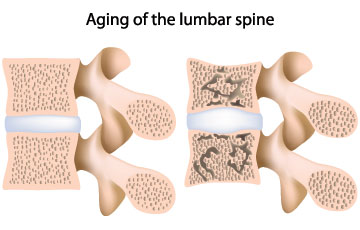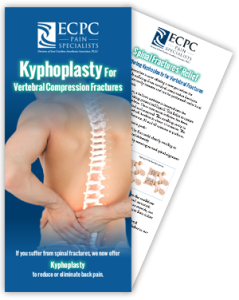

Kyphoplasty
SPINE COMPRESSION FRACTURE & KYPHOPLASTY
For people suffering from osteoporosis (a disease in which causes bones to lose calcium and turn fragile), compression fractures can occur. A compression fracture is defined as a vertebral bone in the spine that has decreased 15-20% in height. These fractures can occur in any vertebrae in the spine, but most commonly occur in the lower vertebrae of the upper back, or the thoracic spine. Other names for compression fractures include vertebral fracture, osteoporotic fracture or wedge fracture. The fracture typically occurs in the front of the vertebrae, collapsing the bone in the front of the spine, and leaving the back of the same bone unchanged, producing a wedge-shaped vertebrae.
Vertebral compression fractures are typically accompanied by acute back pain, which can lead to chronic pain, deformity, height loss, crowding of internal organs, and loss of muscle due to lack of activity. Since the damage is limited to the front of the vertebral column, the fracture is rarely associated with nerve or spinal cord damage. These fractures occur suddenly and are often felt as sharp pains or “knife-like” pains, which can be disabling. Sometimes, compression fractures show no symptoms at first, and then are discovered via X-ray. Along with pain, a stooped-over posture, called kyphosis, can occur. In rare cases, the pressure from hunched over posture can cause numbness, tingling, weakness, difficulty walking and loss of bladder control.
Most compression fractures occur in elderly people with osteoporosis and don’t cause injury to the spinal cord. Pain in these cases can be treated with:
- Pain medicine
- Physical therapy to improve movement
- Back braces
Kyphoplasty is a minimally invasive procedure performed under local or minimum sedation. This procedure is done to prevent further collapse of the fracture, improve the patient’s posture, and reduce or eliminate back pain.
During kyphoplasty, a small incision is made in the back. Then using fluoroscopy, a tube is inserted and guided to the correct position to create a path into the fractured area of the involved vertebrae. The doctor inserts a balloon through the tube and into the vertebrae, carefully inflating it to elevate the fracture and return the pieces to a normal position. This creates a cavity inside the vertebrae. Lastly, the doctor fills the cavity with a cement-like material called polymethyl methacrylate (PMMA), to stabilize the bone.
Pain relief from kyphoplasty will be immediate and patients can return to normal daily activities, with the exception of strenuous activities for at least six weeks. If you are suffering from chronic pain due to compression fractures and osteoporosis, ask your referring physician to schedule an appointment with ECPC Pain Specialists. At your appointment, our specialists will discuss your general health, pain levels and past treatment options to determine if kyphoplasty is the next step in helping you.
Sources:
Medline Plus U.S National Library of Medicine (medlineplus.gov)

